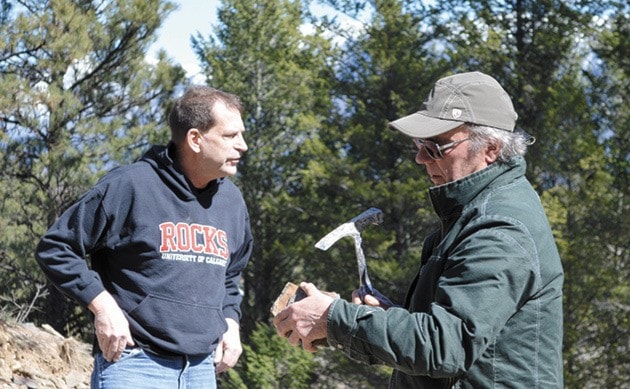While Cranbrook and the surrounding area are known for extracting valuable resources out of the ground with the mines in the Elk Valley, it's a different sort of material found underground that has the scientific community abuzz.
That material would be fossils.
Whether it be trilobites pulled out of the ground around Cranbrook or dinosaur tracks found in Elk Valley mines or mastodon remains discovered in the Flathead, the local geology has a lot of hidden gems for palaeontologists.
Dr. Richard Hebda, a curator of Botany and Earth History at the Royal B.C. Museum in Victoria, is currently in Cranbrook to give a lecture at the Royal Alexandra Hall on Wednesday evening.
Hebda, along with local fossil hunters, visited a site in the region—the location of which is being kept deliberate vague to protect any specimens that could be discovered.
Specimens such as trilobites—a fossil group of extinct marine arthropods, date back to the early Cambrian period roughly 521 million years ago.
"There are many different fossils at many different ages in southeastern British Columbia," said Dr. Hebda. "People may know of dinosaur tracks, for example around the Fernie area—those are from the Mesozoic era, middle-life era. Here, we have much older material, 500-odd million years.
"In any place you find material of that age, it's a wonderful thing, where we can learn what life was like way back then, when you first begin to get the first big organized examples of life."
Dr. Hebda has been with the Royal BC Museum since 1980, and holds a faculty position at the University of Victoria's School of Earth and Ocean Sciences. He serves as the province's expert advisor on Burns Bog and a science advisor on palaeontology.
New species of trilobites are being discovered locally by a Cranbrook fossil hunter that are generating a lot of interest within the scientific community. Chris Jenkins has been working his sites for over 10 years and is still discovering new species.
"We've been doing this long enough now that we're pretty familiar with the known species," Jenkins said. "We know what they're called and we've got all the latin names memorized.So when we do find something that just doesn't match any of the known species, we're pretty sure we've found something new.
"It's exciting, it's not like you have to wait three weeks and get word back from an expert. You know the minute you break the rock and split it open and it's sitting right there, you know you found something new.
"It's kind of what keeps us going."
When Jenkins was first working his sites, he was discovering nearly 10 new species of trilobites a year, which has slowed to about three or four. Once he thinks he has found a new species, he emails a picture to an expert to get a second opinion.
"So once you send a picture off, if it's exciting enough and new enough, you'll get the attention of the palaeontologists and these are the people who come in and classify the fossils and decide whether it deserves a new name or a new entire family," Jenkins said.
Dr. Hebda added that it's not just trilobites that draws paleontological experts to the area.
"The other thing we know, that from this area, comes creatures that are new to science that have been never, ever been seen or described before. That's sort of the Holy Grail of being a scientist or palaeontologist," he said. "To be the place where that stuff that's never been seen on Earth before, that's an amazing thing that's really, really special."
That also means there is significant research value, he continued.
"These are people using resources to come here to this spot, so that makes it extremely important," Dr. Hebda said.
"There are a lot of sites that people don't know about and every one of them has the potential to add some tremendous new kind of knowledge—the discovery of a new group of plants or animals, or seeing that they lived a lot later or earlier than we knew about."
Dr. Hebda's lecture was at the Royal Alexandra Hall, which is a part of the Cranbrook History Centre and features a few trilobite display. Dr. Hebda's lecture also included a portion on the importance of keeping such fossils at institutions within B.C., especially locally.
